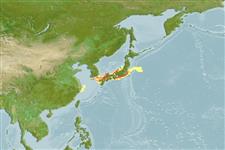>
Ophidiiformes (Cusk eels) >
Bythitidae (Livebearing brotulas)
Etymology: Parabrotula: Greek, para = the side of + Latin, brotula, -ae = little, bud, shoot (Ref. 45335); tanseimaru: Named after R/V Tansei Maru.
Eponymy: ‘Tansei Maru’ is the name of a research vessel, owned by the Ocean Research Institute, University of Tokyo (now Japan Marine Science and Technology Center), which was responsible for collecting the holotypes of the goby and false brotula. (Ref. 128868), visit book page.
More on authors: Miya & Nielsen.
Environment: milieu / climate zone / depth range / distribution range
экология
морской батипелагический; пределы глубины 0 - 1300 m (Ref. 34721). Deep-water
Northwest Pacific: Japan.
Size / Вес / Возраст
Maturity: Lm ? range ? - ? cm
Max length : 5.0 cm SL самец/пол неопределен; (Ref. 34721); 5.0 cm SL (female)
Occurs in pseudoceanic bathypelagic depths. Feeds primarily on copepods (Ref. 34721). Viviparous (Ref. 34721).
Life cycle and mating behavior
половая зрелость | размножение | нерест | икра | Fecundity | личинки
Miya, M. and J.G. Nielsen, 1991. A new species of the deep-sea fish genus Parabrotula (Parabrotulidae) from Sagami Bay with notes on its biology. Jap. J. Ichthyol. 38(1):1-5. (Ref. 34721)
Статус Красного Списка МСОП (Ref. 130435: Version 2024-2)
Угроза для людей
Harmless
Использование человеком
дополнительная информация
инструменты
Специальные отчеты
Скачать в формате XML
ресурсы в Интернет
Estimates based on models
Preferred temperature (Ref.
123201): 0.7 - 16.4, mean 8.5 °C (based on 34 cells).
Phylogenetic diversity index (Ref.
82804): PD
50 = 0.8750 [Uniqueness, from 0.5 = low to 2.0 = high].
Bayesian length-weight: a=0.00813 (0.00246 - 0.02688), b=2.92 (2.67 - 3.17), in cm total length, based on LWR estimates for this (Sub)family-body shape (Ref.
93245).
Trophic level (Ref.
69278): 3.0 ±0.00 se; based on food items.
устойчивость к внешним воздействиям (Ref.
120179): высокий, минимальное время удвоения популяции до 15 месяцев (Preliminary K or Fecundity.).
Fishing Vulnerability (Ref.
59153): Low vulnerability (10 of 100).
